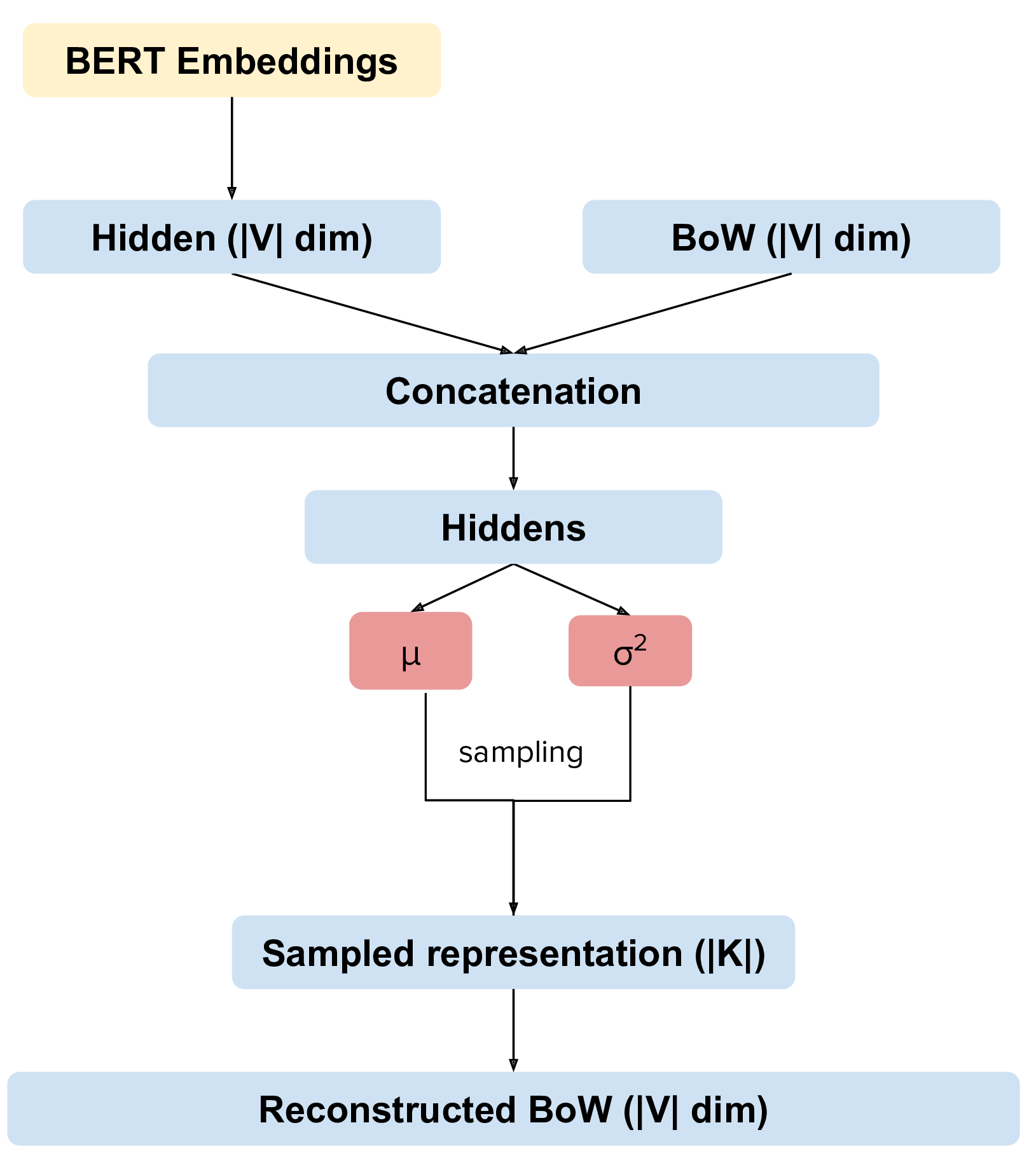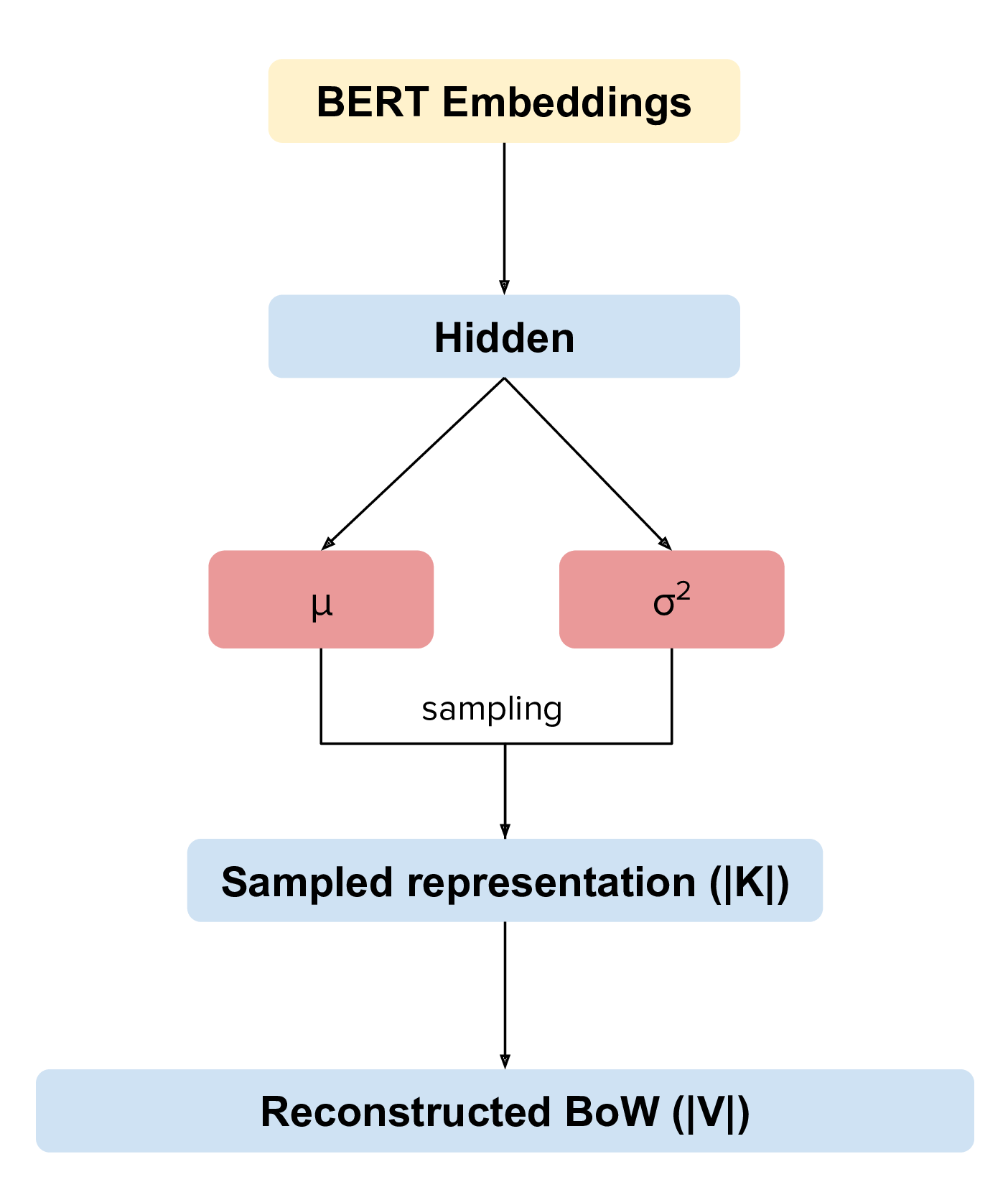


Contextualized Topic Models (CTM) are a family of topic models that use pre-trained representations of language (e.g., BERT) to support topic modeling. See the papers for details:
- Cross-lingual Contextualized Topic Models with Zero-shot Learning https://arxiv.org/pdf/2004.07737v1.pdf
- Pre-training is a Hot Topic: Contextualized Document Embeddings Improve Topic Coherence https://arxiv.org/pdf/2004.03974.pdf
Make sure you read the doc a bit. The cross-lingual topic modeling requires to use a "contextual" model and it is trained only on ONE language; with the power of multilingual BERT it can then be used to predict the topics of documents in unseen languages. For more details you can read the two papers mentioned above.


Software details:
- Free software: MIT license
- Documentation: https://contextualized-topic-models.readthedocs.io.
- Super big shout-out to Stephen Carrow for creating the awesome https://github.com/estebandito22/PyTorchAVITM package from which we constructed the foundations of this package. We are happy to redistribute again this software under the MIT License.
- Combines BERT and Neural Variational Topic Models
- Two different methodologies: combined, where we combine BoW and BERT embeddings and contextual, that uses only BERT embeddings
- Includes methods to create embedded representations and BoW
- Includes evaluation metrics
Install the package using pip
pip install -U contextualized_topic_modelsThe contextual neural topic model can be easily instantiated using few parameters (although there is a wide range of parameters you can use to change the behaviour of the neural topic model). When you generate embeddings with BERT remember that there is a maximum length and for documents that are too long some words will be ignored.
An important aspect to take into account is which network you want to use: the one that combines BERT and the BoW or the one that just uses BERT. It's easy to swap from one to the other:
Combined Topic Model:
CTM(input_size=len(handler.vocab), bert_input_size=512, inference_type="combined", n_components=50)Fully Contextual Topic Model:
CTM(input_size=len(handler.vocab), bert_input_size=512, inference_type="contextual", n_components=50)Here is how you can use the combined topic model. The high level API is pretty easy to use:
from contextualized_topic_models.models.ctm import CTM
from contextualized_topic_models.utils.data_preparation import TextHandler
from contextualized_topic_models.utils.data_preparation import bert_embeddings_from_file
from contextualized_topic_models.datasets.dataset import CTMDataset
handler = TextHandler("documents.txt")
handler.prepare() # create vocabulary and training data
# generate BERT data
training_bert = bert_embeddings_from_file("documents.txt", "distiluse-base-multilingual-cased")
training_dataset = CTMDataset(handler.bow, training_bert, handler.idx2token)
ctm = CTM(input_size=len(handler.vocab), bert_input_size=512, inference_type="combined", n_components=50)
ctm.fit(training_dataset) # run the modelSee the example notebook in the contextualized_topic_models/examples folder. We have also included some of the metrics normally used in the evaluation of topic models, for example you can compute the coherence of your topics using NPMI using our simple and high-level API.
from contextualized_topic_models.evaluation.measures import CoherenceNPMI
with open('documents.txt',"r") as fr:
texts = [doc.split() for doc in fr.read().splitlines()] # load text for NPMI
npmi = CoherenceNPMI(texts=texts, topics=ctm.get_topic_lists(10))
npmi.score()The fully contextual topic model can be used for cross-lingual topic modeling! See the paper (https://arxiv.org/pdf/2004.07737v1.pdf)
from contextualized_topic_models.models.ctm import CTM
from contextualized_topic_models.utils.data_preparation import TextHandler
from contextualized_topic_models.utils.data_preparation import bert_embeddings_from_file
from contextualized_topic_models.datasets.dataset import CTMDataset
handler = TextHandler("english_documents.txt")
handler.prepare() # create vocabulary and training data
training_bert = bert_embeddings_from_file("documents.txt", "distiluse-base-multilingual-cased")
training_dataset = CTMDataset(handler.bow, training_bert, handler.idx2token)
ctm = CTM(input_size=len(handler.vocab), bert_input_size=512, inference_type="contextual", n_components=50)
ctm.fit(training_dataset) # run the modelOnce you have trained the cross-lingual topic model, you can use this simple pipeline to predict the topics for documents in a different language.
test_handler = TextHandler("spanish_documents.txt")
test_handler.prepare() # create vocabulary and training data
# generate BERT data
testing_bert = bert_embeddings_from_file("spanish_documents.txt", "distiluse-base-multilingual-cased")
testing_dataset = CTMDataset(test_handler.bow, testing_bert, test_handler.idx2token)
# n_sample how many times to sample the distribution (see the doc)
ctm.get_thetas(testing_dataset, n_samples=20)All the examples we saw used a multilingual embedding model distiluse-base-multilingual-cased.
However, if you are doing topic modeling in English, you can use the English sentence-bert model. In that case,
it's really easy to update the code to support mono-lingual english topic modeling.
training_bert = bert_embeddings_from_file("documents.txt", "bert-base-nli-mean-tokens")
ctm = CTM(input_size=len(handler.vocab), bert_input_size=768, inference_type="combined", n_components=50)In general, our package should be able to support all the models described in the sentence transformer package.
Do you need a quick script to run the preprocessing pipeline? we got you covered! Load your documents and then use our SimplePreprocessing class. It will automatically filter infrequent words and remove documents that are empty after training. The preprocess method will return the preprocessed and the unpreprocessed documents. We generally use the unpreprocessed for BERT and the preprocessed for the Bag Of Word.
from contextualized_topic_models.utils.preprocessing import SimplePreprocessing
documents = [line.strip() for line in open("documents.txt").readlines()]
sp = SimplePreprocessing(documents)
preprocessed_documents, unpreprocessed_corpus, vocab = sp.preprocess()- Federico Bianchi <f.bianchi@unibocconi.it> Bocconi University
- Silvia Terragni <s.terragni4@campus.unimib.it> University of Milan-Bicocca
- Dirk Hovy <dirk.hovy@unibocconi.it> Bocconi University
If you use this in a research work please cite these papers:
Combined Topic Model
@article{bianchi2020pretraining,
title={Pre-training is a Hot Topic: Contextualized Document Embeddings Improve Topic Coherence},
author={Federico Bianchi and Silvia Terragni and Dirk Hovy},
year={2020},
journal={arXiv preprint arXiv:2004.03974},
}
Fully Contextual Topic Model
@article{bianchi2020crosslingual,
title={Cross-lingual Contextualized Topic Models with Zero-shot Learning},
author={Federico Bianchi and Silvia Terragni and Dirk Hovy and Debora Nozza and Elisabetta Fersini},
year={2020},
journal={arXiv preprint arXiv:2004.07737},
}
This package was created with Cookiecutter and the audreyr/cookiecutter-pypackage project template. To ease the use of the library we have also included the rbo package, all the rights reserved to the author of that package.
Remember that this is a research tool :)